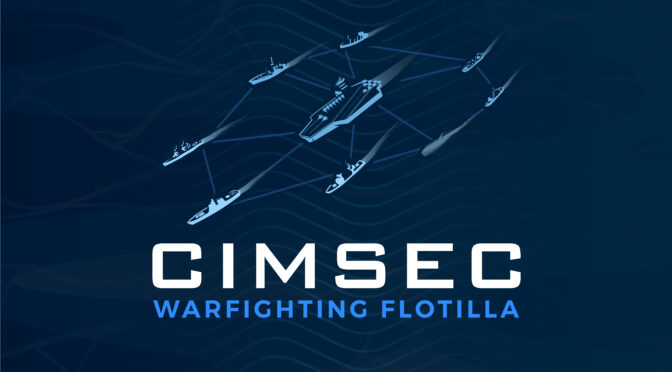By Dmitry Filipoff
This month the CIMSEC Warfighting Flotilla will discuss the state of the Navy’s Information Warfare Community, managing information superiority through TACSIT practices, and revamping professional military education. If you haven’t already, sign up through the form below to become a Flotilla member and receive the invites to our upcoming off-the-record October discussions. The listings for these upcoming discussions are featured down below.
Last month the Flotilla discussed SWO warfighting culture, cross-community integration with the submarine force, and the state of mission command. Each of these discussions revealed interesting opportunities and shortfalls in naval force development and operations, while growing connections between the participating navalists and warfighters.
Feel free to visit the Flotilla homepage to learn more about this community, its activities, and what drives it.
Upcoming October Sessions
Consolidating Navy Information Warfare
The Navy combined its various information-focused communities into the overarching Information Warfare Community more than a decade ago. The extent to which this reorganization has enhanced the effectiveness of Navy information warfare as a whole and the information communities individually remains open to debate. How has this community construct enhanced the information warfare capability of the Navy? Has the IW community come into its own as a more effective institutional player that can advocate for IW needs? Join us to discuss these questions and more as we consider the state of the Navy’s IW community.
Read Ahead: “The Navy Information Warfare Communities’ Road to Serfdom,” by Capt. Bill Bray (ret.)
____________________________________________
Managing TACSIT for Information Superiority
Forces must deny information to the adversary while securing it for themselves. For the U.S. Navy, the “tactical situation” or TACSIT framework helps operators understand the scope of their situational awareness and that of the adversary’s. How can naval forces better manage information and signatures to reduce their exposure while still securing similar information about an adversary? How can operating practices and force development improve TACSIT awareness and potential? Join us to discuss these questions and more as we consider methods of information superiority in naval warfighting and operations.
Read Ahead: “Living in TACSIT 1,” by CDR Bryan Leese
____________________________________________
Revamping PME
Professional military education serves a critical function in educating warfighters and broadening their understanding. Yet PME must be flexible to meet the demands of changing times, and it must be valued and incentivized by promotion practices. How can the naval services improve PME to enhance the knowledge and understanding of warfighters? How can the services reform PME to be more relevant to great power threats and demands? Join us to discuss these questions as we debate how to improve professional military education.
Read Ahead: “Weaponize PME to Improve the Force,” by Capt. Bobby Holmes, USMC
____________________________________________
Completed September Sessions
____________________________________________
SWO Warfighter Mentality
The Surface Warfare community is challenged by many factors, including high operational demand, onerous administrative requirements, extensive maintenance obligations, and other issues. Amidst these challenges, the warfighting culture of the Surface Navy has come under greater scrutiny, including from Congress. What is the state of the warfighting culture of the Surface Navy and how is it trending? What habits and mentalities need to be learned and unlearned? How must culture evolve to meet threats posed by great powers? Join us to discuss these questions and more as we consider the warfighting culture of the Surface Navy.
Read Ahead: “The State of the Warfighter Mentality in the SWO Community,” by Lt. Judith Rooney
____________________________________________
Submarine Integration
The submarine force has had its heavily focus affected by the War on Terror like other Navy communities, and with a greater emphasis on independent action. As great power threats grow, the Navy must consider how to more closely integrate the submarine force with other elements of naval power for both peacetime and wartime operations. How can the submarine force better integrate with other navy communities to enhance combined effectiveness? What sorts of measures and efforts can enhance cross-community understanding and force development? Join us for our discussion on how the submarine force can be more closely integrated with other elements of naval power.
Read Ahead: “Independent but Integrated,” by Capt. Dick Corpus (ret.) and Capt. Kevin Eyer (ret.)
____________________________________________
Evolving Mission Command
Mission command is an important principle for launching effective operations and creating flexible command relationships. But while mission command is often touted in doctrinal publications, it may not be well-practiced in reality, with more micromanagerial command relationships often spreading in the information age. What is the state of mission command and the degrees of trust between higher and lower echelons across chains of command? What various states of mission command are better suited to peacetime and wartime operations? Join us to discuss mission command and themes of command relationships in this upcoming discussion.
Read Ahead: “The Atrophy of Mission Command,” by Capt. Rob Peters and Capt. Benjamin Miller, U.S. Navy, and LtCol. Brian Hanrahan, U.S. Army
____________________________________________
Dmitry Filipoff is CIMSEC’s Director of Online Content and Community Manager of the Warfighting Flotilla. Contact him at Content@cimsec.org.

